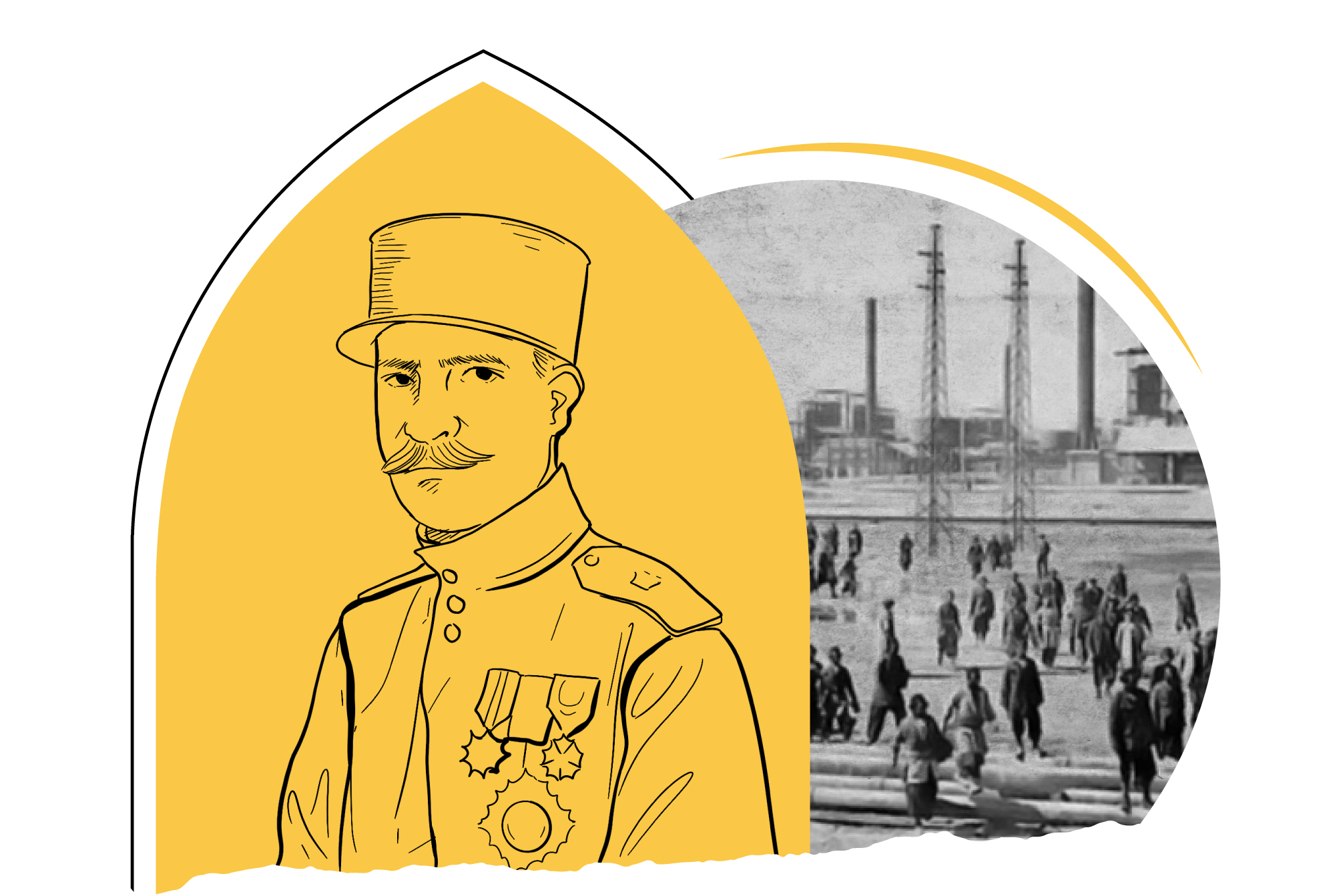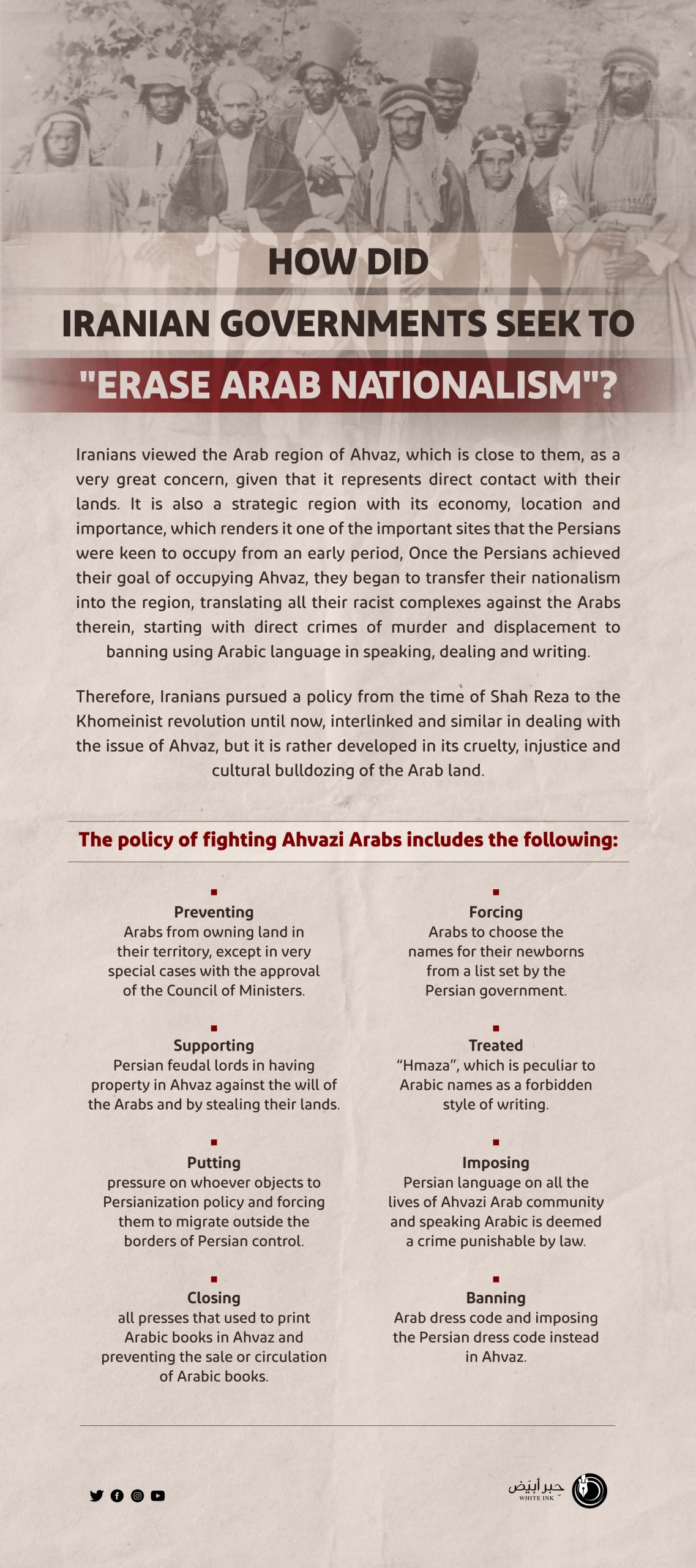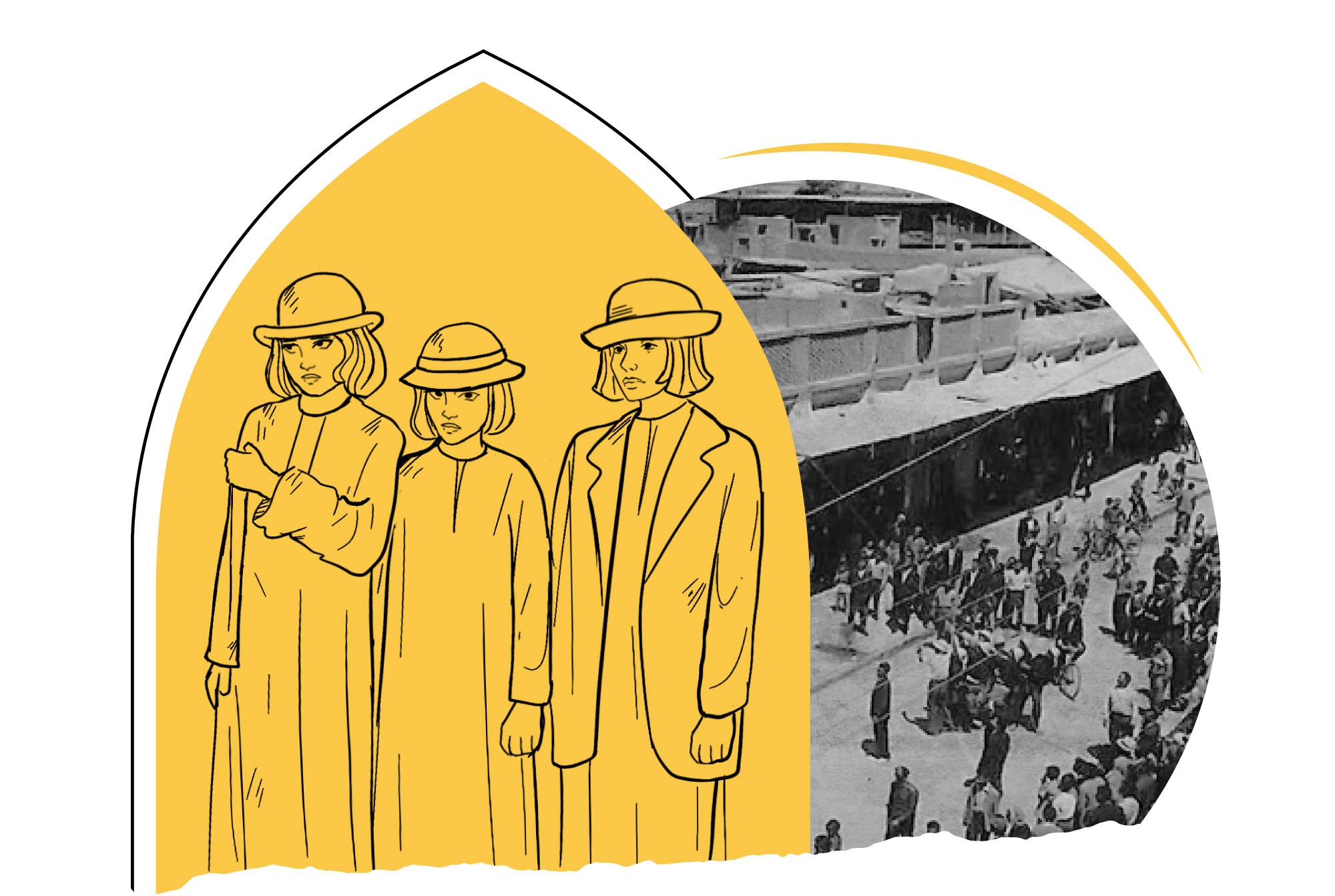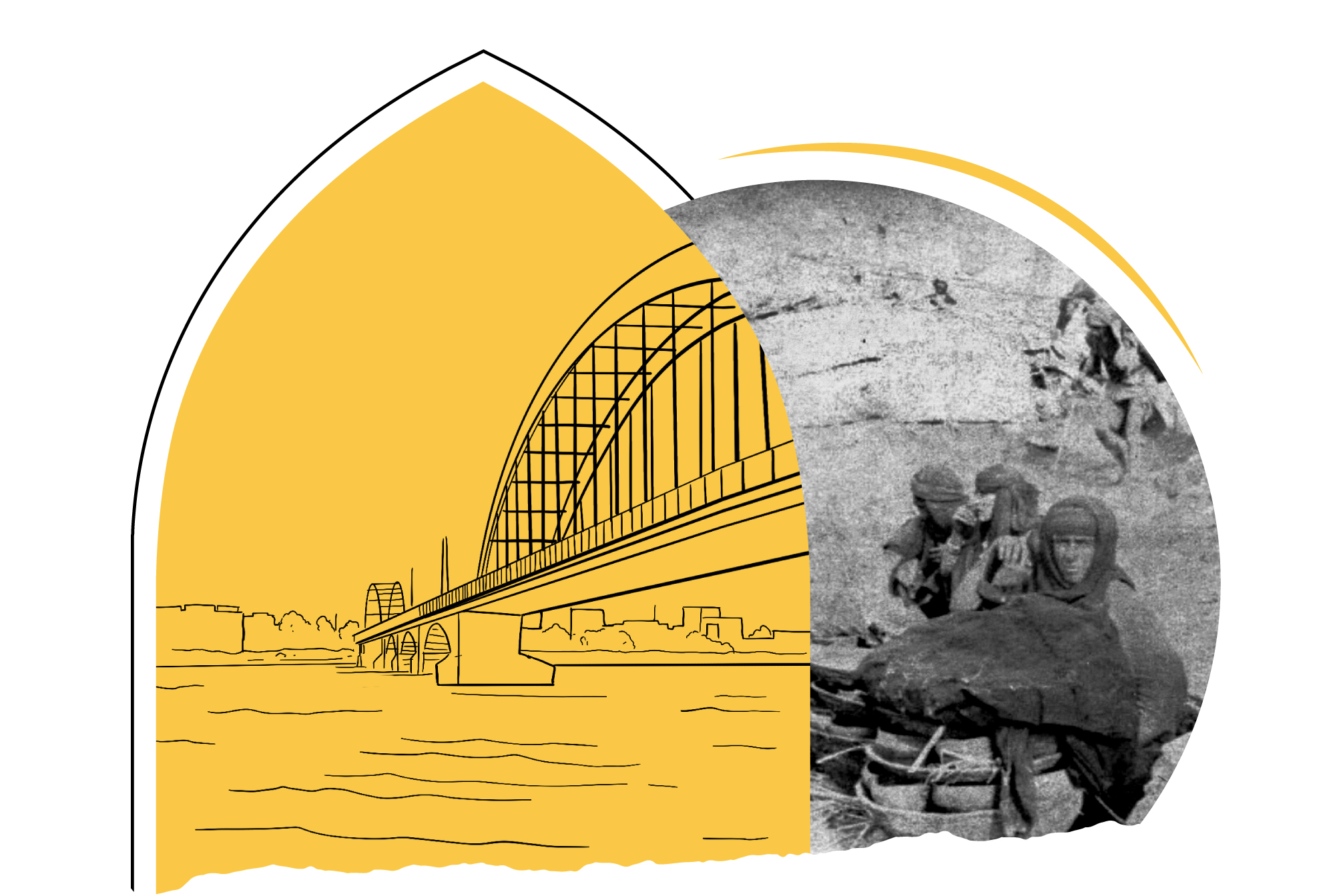
Through Racist Policy
Arabs were Prohibited from Owning Lands
or Real Estate, except, and exceptionally, with the Special Approval of Iranian Council of Ministers
Iran’s occupation of Ahvaz, the Emirate of Muhammarah in Arabistan, was for several ambitions, the most important of which was racism and economic exploitation. As for Persian racism towards the Arabs, after years of Arab sovereignty, was due to fire raging in the hearts of the Persians towards the Arabs. On the other hand, Tehran realized the economic importance of Ahvaz, whether in terms of abundance of fresh water through its rivers or the oil fields therein. It is known that most of Iran’s oil comes from Ahvaz. That is why Reza Shah Pahlavi occupied Ahvaz and annexed it to Iran in 1925, in a treacherous operation in which he colluded with England. Ahvazi Arabs were a victim of that collusion after their Emir, Sheikh Khazal Al-Kaabi, was arrested and exiled to Tehran until his death, which some researchers believe was an unnatural death at the hands of Iranian security agents.
In a legal memorandum, from the point of view of international law, researcher Amer al-Dailami describes Iran’s takeover of Ahvaz as “an occupation in accordance with United Nations resolutions and international decolonization contracts”. From this point, he believes that Iran has violated international conventions that regulate the situation of occupation, where it turned into Persian persecution that amounted to the level of committing brutal massacres by killing and arresting innocent Ahvazi people. This led to great human losses, in addition to a lot of material damage. This Persian oppression was manifested in numerous military and paramilitary actions, overt or covert.
From an early age, Tehran implemented a systematic policy of demographic change in Ahvaz as, since 1928, it has brought thousands of families of Persian farmers to the areas of Ahvaz, which are characterized by the fertility of its lands, so as to begin the process of displacement and replacement of population. Further, Iranian authorities encourage the Persian elements to procreate, within the scheme of “demographic fertilization” in Ahvaz, at the expense of the local Arab element.
On the other hand, increase in the discovery of oil in Ahvaz and the transformation of the port and refinery of Abadan into the most important oil centers in Iran, attracted large numbers of Persian immigrants from various Iranian cities. Undoubtedly, the Iranian administration helped in that, which some describe as the “Persian policy of discrimination against Arab people in Ahvaz in terms of employment and culture”.
Perhaps the most important crime of Tehran in the matter of forced displacement and demographic discrimination is its encouragement of Persian feudal lords to plunder the lands of simple Arab farmers in Ahvaz and Arab landowners working in other professions, such as service employees and taxi drivers. These actions, which are contrary to all humanitarian conventions, were justified by compensating those simple Arabs with other lands in northern Iran, which did not happen. The fact is that Tehran was seeking to push these Arabs to leave their homeland in Ahvaz in favor of the Persian feudal lords, in what is deemed a forced displacement.
In (1962) Tehran issued the Agrarian Reform Law, as many Persian peasants from outside Ahvaz were granted large lands in that region, while every Arab was forbidden to own land or real estate except with the special approval of the Iranian Council of Ministers.
The policy of forced displacement and demographic discrimination was not limited to the Shah’s era only. The same policy continued during the era of the Khomeinist Republic, when several thousand Arabs were displaced from their homeland, especially the fertile areas on both sides of Karun River. Tehran also established many agricultural settlements and brought Persian settlers thereto in order to further demographic change in Ahvaz. Accordingly, Amnesty International declared in its report that “Iranian authorities confiscate vast areas of land with the aim of depriving Arabs of their lands, under a strategy that aimed at forcibly transferring Arabs from their lands to other regions, while facilitating the movement of non-Arabs to Arabistan”.
This was strongly reflected in the political situation in Al-Ahvaz. In 2005, Ahvaz witnessed a major uprising that spread throughout the region, rejecting the policies of forced displacement, the expulsion of many Arab elements and the replacement of other elements.
The impact of the policy of forced displacement and demographic discrimination on Arab representation in the Iranian Parliament is also mentioned, as it has dropped from thirteen (13) in the early twenty-first century to just two (2) representatives. Thus, Tehran practiced a policy of forced displacement and settler colonialism against the Ahvazi Arabs, ignoring all international covenants and agreements.
The number of Arab representatives in the Iranian Parliament has been reduced from 13 to two.



- Farah Saber, Reza Shah Pahlavi… Political Developments in Iran 1918-1939 (Sulaymaniyah: Kurdistan Center for Strategic Studies, 2013).
- Amer Al-Dailami, Iranian Occupation of the Arab Region of Al-Ahvaz, United Nations Resolutions and International Contracts to Decolonization (Amman: Academic House Company, 2021).
- Athbi Al-Otaibi, Iranian occupation of the Emirate of Arabistan and its People’s Right to Self-Determination, Master’s Thesis in Political Science (Amman: Middle East University, 2013).
- Ali Mohafaza, Arabs and the Contemporary World (Cairo: Dar Al-Shorouk, 2009).


Forcing Reading Persian Newspapers
Preventing Arabs from Printing Books in their Own Language
Since full Iranian occupation of Arab Ahvaz in 1925, Iranians have been preoccupied with erasing the Arab identity of the region in order to turn it into a pure Iranian. The Persians who remained for 14 centuries fighting the Arabs who defeated them in Qadissiyah would not accept having Arabs living among them, with their own language, identity and independent culture, with lands that contain a wealth of oil, gas, water, agriculture and fisheries. It is an equation that Persian arrogance and hatred cannot accept. Therefore, Iranian occupation has made great efforts to abolish the Arab identity, get rid thereof and erase it ultimately.
Iranian policy for the Persianization of Ahvaz and erase of Arab identity, culture and language was not limited to Arabs only, but rather it was a scorched-earth policy in order to evacuate the indigenous population and replace them with pure Persians. In his research, “Iranian Deviation Policy: Arabistan of Ahvaz as an example”, says in confirmation of the above: “The Iranians deliberately obscure the language, history, customs and traditions of the peoples and nationalities under their occupation, to the extent of changing the names of people, streets, neighborhoods and cities, even the customs of clothing and dresses, which indicate the identity and nationality of these peoples. That change also included the folklore of those peoples. Persianization policy was not limited to Ahvazi Arab people in Arabistan, but rather extended to other nationalities. Since Iran occupied the lands of Baluchistan in 1928, the same policy is practiced against the Kurds in their regions.
On their part, Baqir Al-Sarraf and Adel Al-Suwaidi, researchers in Persian affairs, point out in their book, Is the Gulf Arab or Persian?, that “What happened to the Arab region of Ahvaz, which covers an area of 324 thousand square kilometers, is a military occupation, followed by a practice that aimed at eliminating the national identity of the inhabitants of the occupied homeland favor of different concepts. The region of Ahvaz was part of the “great” Arab homeland before its occupation by Iran in 1925, with British complicity, when it helped the former Shah to implement his own expansionist goals.
Even today, Iranian occupier seeks to increase the percentage of non-Arabs in Ahvaz and to change the original Arabic names of cities, towns, rivers and other geographical locations in the Ahvaz region. The city of Muhammarah, for example, became known as (Khorram Shahr), which is a Persian word meaning the green country. The process of changing the Arab character included all aspects of life in Ahvaz after its Safavid occupation, with the aim was to impose Persian culture. On top of the taboos approved by the Iranian-Persian occupation was speaking in Arabic language in public places, where whoever violates that matter in punishable, as speaking in Arabic language is a crime punishable by Safavid law. Iran also decided that school curricula should be in Persian language only, where it is not permissible to speak any other language and Ahvazis were prevented from naming their newborns with Arabic names, nor wearing Arab dress; they were forced to replace it with Persian Pahlavi dress.
When Tehran government found violent Arab resistance to its ambitions, it resorted to indirect methods to force the people of Ahvaz to abandon their Arabic language, including changing the names of the Arab regions with Persian names, so the Hawiza city became (Dasht-Mishan), Al-Khafajiah became (Susankerd), Al-Salihiya became (Andmeeshk), Ahvaz became (Khuzestan) and the port of Khor Abdullah became (Bandar Shahpur port) and Khazali Street in Muhammarah became (Pahlavi Street).
They also published a newspaper in Muhammarah, named Khuzestan Newspaper, published in Persian, where the people of Ahvaz are obligated to buy and read it, while they are prevented from the circulation of Arabic publications, and those who circulated them were brought to the courts for violating one of the taboos punishable by law.
Undoubtedly, the crime of the Mongols in Baghdad is one of the major human crimes, when they expropriated money and honour, but their cultural crime of burning and throwing the reservoir of Arab knowledge into Tigris and Euphrates rivers was the greatest crime. A similar crime was committed by the Iranian Persians in their undertaking a campaign of full removal of Ahvazi Arab culture by seizing all private libraries of the Ahvazis and transferring their contents to Iran. Many of them were destroyed and thrown into Karun River, which turned into a symbol of the Persian-Iranian crime against the Ahvazis. Printing press in the city of Muhammarah was closed for fear that Arabic books would be printed, or even pamphlets hostile to the Iranian occupation. Bookstores selling Arabic publications were closed, their contents were confiscated and owners were abused.
In order to force the Ahvazis to give up their Arabic language and convert into Persian, Iranian government rejected all administrative transactions if they were not in Persian language, and prevented the Ahvazis them from visiting government departments unless they can deal with the employees was in Persian. Testimony of any Arab is not accepted in the courts if he cannot speak Persian, under the pretext that the judges are not fluent in Arabic language. Even interpreter for the Arabs were not admitted to the courts. This is in addition to preventing any Arab from joining a government job unless he proves his proficiency in Persian language. That procedure led to the exposure of many Ahvazi people who refused to speak Persian to homelessness outside Ahvaz.
Iranian occupation state also focused on preventing Ahvazis from wearing Arab dress in government institutions, as well as in public places, including sports centers. In order to disentangle Ahvazi Arabs from their history and cultural heritage. Persian occupation demolished and destroyed many historical monuments in Ahvaz, where most of the palaces and government buildings dating back to the period of the rule of Sheikh Khazal bin Jaber were completely destroyed and what remains thereof is about to fall and disappear as a result of deliberate negligence by the local authorities of the occupation. This is in addition to blowing up the entire Faili Palace, which is the palace overlooking Shatt Al-Arab near Muhammarah city, although it is one of the historical monuments listed on the list of antiquities that must be protected according to local laws.
If there is a term that can describe Iranian occupation of Arab Ahvaz, it shall be the “abhorrent and hateful” occupation. They prevented the Ahvazis from naming their children with Arabic names and allocated a list of permitted names that was circulated to competent authorities, including the names of the imams in the sect, in addition to a few Arab names that are not hostile to revenge and hostility to some Arab symbols, according to Persian mentality. All remaining names are Persian names that have no connection with Arab culture. Iranians were intransigent until they banned the use of hamza in names such as (Jida’, Asma’, Hawra’, Israa’, Shaima’ ) and ordered them to be written as (Jida, Asma, Hawra, Israa, Shaima).
Prevented writing names in Arabic “hamza”, such as: Jaida’, Asma’, etc.



- Ibrahim Al-Obeidi, Ahvaz… A Stolen Arab Land (Baghdad: Dar Al-Hurriya Printing House, 1980).
- Baqer Al-Sarraf and Adel Al-Suwaidi, Is the Gulf Arab or Persian? (Cairo: Jazirat Al-Ward Library, 2012).
- Khaled Al-Masalmeh, Occupied Arab Territories of Ahvaz, 2nd Edition (Germany: Center for German-Arab Studies, 2008).
- Amer Al-Dulaimi, Iranian Occupation of the Arab Region of Ahvaz (Amman: Academicians Publishing House, 2020).

Persianization by Terrorism
"Demographic Erasure" of Ahvaz by Iran Since its Occupation in 1925
Study of the history of colonial policies in the world concludes that “colonialism” took many forms, and the methods of subjugation developed from mere appropriation of land and enslavement of people to attempts to possess their minds and hearts, through a set of measures that aim to separate colonized peoples from their cultural identity and ethnic cohesion, before transforming them to a human extension of the peoples of the colonial countries.
If classical colonialism had striven to exploit tactics of control, the Persians have gone to extremes in the forms of colonialism by resorting to the strategy of “demographic erasure” against Ahvazi Arab component, which is a strategy that is based on two main pillars: displacement and Persianization. As the Persians needed the arms of Ahvazi Arabs, they accepted their bodies and rejected their minds, hearts and tongues. Thus, Persianization was the tactic used in the process of “demographic erasure” or “civilizational cutting”.
A look at the history of Ahvaz reveals that the connection with the Arabic language was religious, sentimental and national, which was embodied in the large number of books that taught children the origins of the Arabic language, jurisprudence and grammar, in addition to the schools that benefited from state support, especially during the era of Sheikh Khazal Al-Kaabi (Khazaliya, Jasabiyyah and Tarbiyyah).
Ahvazi people’s behavioral and cultural connection to Arabic language and culture had aroused the ire of the Persians, who were preparing to occupy Arabistan. This prompted one of the Persian officials to warn about the contents of what was written in the newspapers issued in the state of Arabistan, expressing his rejection to the Arab library and its contents.
From this point of view, it becomes clear to us that Persian plans were not hidden from the Arabs of Ahvaz, which prompted them to fortify behind their language, value and instill it in their souls and hearts before their minds and cores. This is exactly what assures to us that Arab resistance to the waves of Persianization is the culmination of this pan-Arabist approach before the Persian occupation of that Arab region.
If the occupation of Ahvaz contributed to the Persians continuing the series of material exploitation of “demographic erasure” strategy, where “Iran proceeded with its steps to Persianize the region, this caused reactions among its people to carry out unorganized, sporadic and far-flung revolutions”.
The Persians became certain that the center of gravity of Ahvazi people’s resistance is the Arabic language. Thus, they strived to sever the relationship between the Ahvazis and their mother tongue by resorting to installing Persian in the place of Arabic language, cutting the tool of control and link among the Ahvazis, trying to forcibly link them to the Persian nation. The Persians adopted a set of “cutting tactics”, including changing the names of Arab places with Persian ones. Tehran issued a newspaper in the city of Muhammarah, called Khuzestan Newspaper, published in Persian, obligating the people of Ahvaz to buy and read it. They prevented the circulation of Arabic publications and whoever circulated them was subjected to the judiciary for violating a taboo punishable by law.
Iranian hatred and Persian arrogance, as well as the attempt to obliterate the Arab Ahvazi identity, make it clear that the victory of the sect is a mere political piety and a Trojan horse that the Persians used to try to legitimize old ambitions and buried grudges. Otherwise, how do we explain the persecution of Ahvazi Arabs, most of whom are Shiites, who have close ties to Shiite Arab Hawazis, especially in Iraq?
Perhaps publicizing this forgotten issue requires strengthening the Arab component and adopting it politically, diplomatically and in the media, being the strength of the steadfastness front within Arabistan. In this regard, it is possible to take advantage of the mass migration towards virtual space to create the largest number of sites directed to Ahvazi interior, turning them into platforms for framing and guidance on the one hand, and linking Ahvazi components to each other, on the other hand. This would create momentum around the Ahvazi issue that was wronged as no other Arab cause was wronged.
Arab blood is one and the Arab concern is one. If the Palestinian cause is considered the cause of all Arabs and Muslims, then Ahvazi cause must also be the cause of Arabs and Muslims, and the liberation of Ahvazis will lead to the return of the right to its people and to a shift in the balance of power in the region in the interest of the Arabs from the ocean to the Gulf.
"Ahvaz" is an Arab Issue that is not less important than any other national issue.



- Amer Al-Dailami, Iranian Occupation of the Arab Region of Al-Ahvaz, United Nations Resolutions and International Contracts to Decolonization (Amman: Academic House Company, 2021).
- Athbi Al-Otaibi, Iranian occupation of the Emirate of Arabistan and its People’s Right to Self-Determination, Master’s Thesis in Political Science (Amman: Middle East University, 2013).
- Alaa Nawras and Imad Raouf, Linguistic Analysis in Ahvaz: A Documentary Study (Baghdad: Dar Al-Rasheed, 1982).
- Mustafa Al-Najjar, Political History of the Arab Emirate of Arabistan 1897-1925 (Cairo: Dar Al-Maarif, 1980).





